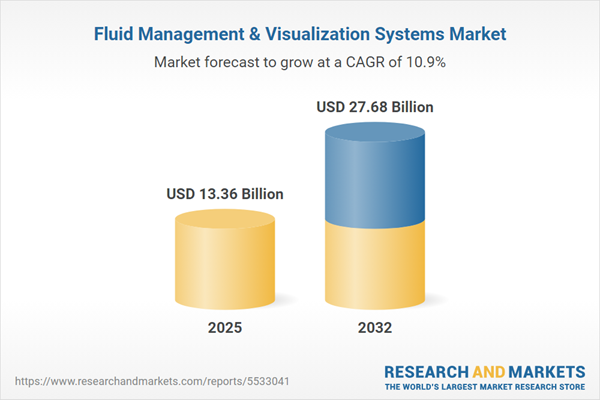Speak directly to the analyst to clarify any post sales queries you may have.
Fluid management & visualization systems are transforming operational practice in modern industry, empowering leaders to optimize efficiency, foster digital integration, and support data-driven decision-making across complex environments.
Market Snapshot: Fluid Management & Visualization Systems Market
In 2024, the global fluid management & visualization systems market is valued at USD 12.06 billion, projected to reach USD 13.36 billion in 2025, with an expected CAGR of 10.93%. Substantial growth is anticipated, targeting a market size of USD 27.68 billion by 2032. Widespread adoption of Industry 4.0 practices, increased digital transformation investments in manufacturing, and a focus on connectivity and operational intelligence are driving new opportunities. Market participants are enhancing digital infrastructures, integrating comprehensive analytics, and rethinking process controls to strengthen competitiveness, with these advanced platforms now essential for operational excellence across various sectors.
Scope & Segmentation in the Fluid Management & Visualization Systems Market
This section gives senior executives an actionable segmentation overview to better align technology selection, operational improvements, and investment priorities with market realities and region-specific needs.
- Offering: Integrated hardware, specialized consulting, ongoing technical support, and analytics-powered software that enable continuous control and oversight of industrial workflows.
- Product Range: Pumps and valves, precision monitoring devices, acoustic and inline leak detectors, user-centric visualization solutions, and flexible fluid handling modules for varied operational demands.
- Technology Focus: Advanced electrochemical sensors including amperometric and potentiometric types, alongside optical imaging, spectrophotometry, ultrasonic Doppler, time-of-flight sensors, and multi-sensor platforms for robust condition monitoring.
- End Use Industry: Biotechnology, chemical manufacturing, pharmaceuticals, food and beverage, and oil and gas, each presenting unique compliance and operational performance criteria.
- Application: Rapid leak detection, process automation, safety monitoring, industrial filtration, and precise dilution management designed to safeguard assets and support quality assurance.
- Deployment: Cloud-based SaaS, hybrid, and on-premise deployment models facilitate secure management in both single-facility and multi-site organizations, offering scalability and resilience.
- Regions Covered: North America, Latin America, Europe, Middle East & Africa, and Asia-Pacific, each requiring tailored approaches that address regulatory variation and different technology adoption rates.
Key Takeaways for Senior Decision-Makers
- Deploying advanced fluid management platforms increases organizational agility and positions leaders to navigate evolving technology and compliance expectations in their industries.
- Modular, open architecture solutions simplify integration with legacy assets, ensuring gradual system expansion as business requirements shift.
- Energy optimization and predictive maintenance embedded in workflow solutions support responsible resource management and align with environmental, social, and governance (ESG) objectives.
- Automated diagnostics and real-time monitoring maintain throughput while helping to reduce process disruptions and unscheduled shutdowns.
- Strategic supply chain frameworks help secure supplier reliability, offering resilience amid shifting demand and market pressures.
- Customizable designs reinforce consistent compliance and operational standards, enhancing risk mitigation across diversified locations.
Tariff Impact: Navigating Regulatory Shifts and Supply Chain Realignment
Recent U.S. tariff adjustments have raised sourcing costs for essential hardware and sensor components in the fluid management & visualization systems market. To address this, organizations are expanding and regionalizing their supplier networks and refining production strategies. These adaptations support supply chain security and help maintain stability and reliability despite changing regulatory requirements.
Methodology & Data Sources
This analysis is based on primary industry research, meticulous regulatory reviews, and insights from peer-reviewed sources. Direct interviews with market and technical experts ensure that findings remain relevant to executive decision-making and strategic business growth.
Why This Report Matters
- Delivers actionable, segment-centric insights supporting executive-level planning, procurement, and investment in fluid management & visualization systems.
- Helps organizations build resource-efficient, compliant, and resilient operations despite regulatory and supply chain complexity worldwide.
- Enables data-informed technology adoption and investment strategies that keep pace with evolving organizational and market objectives.
Conclusion
Fluid management & visualization systems offer a robust avenue to enhance operational workflows. This report equips senior leaders with the information needed to drive innovation and stay responsive in dynamic sector landscapes.
Additional Product Information:
- Purchase of this report includes 1 year online access with quarterly updates.
- This report can be updated on request. Please contact our Customer Experience team using the Ask a Question widget on our website.
Table of Contents
3. Executive Summary
4. Market Overview
7. Cumulative Impact of Artificial Intelligence 2025
Companies Mentioned
The companies profiled in this Fluid Management & Visualization Systems market report include:- Emerson Electric Co.
- Siemens Aktiengesellschaft
- ABB Ltd.
- Schneider Electric SE
- Honeywell International Inc.
- Danaher Corporation
- Endress+Hauser AG
- Yokogawa Electric Corporation
- KROHNE Messtechnik GmbH
- VEGA Grieshaber KG
Table Information
| Report Attribute | Details |
|---|---|
| No. of Pages | 186 |
| Published | November 2025 |
| Forecast Period | 2025 - 2032 |
| Estimated Market Value ( USD | $ 13.36 Billion |
| Forecasted Market Value ( USD | $ 27.68 Billion |
| Compound Annual Growth Rate | 10.9% |
| Regions Covered | Global |
| No. of Companies Mentioned | 11 |









